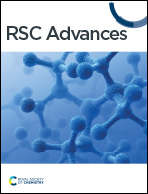Photocatalyzed hydrodecarboxylation of fatty acids: a prospective method to produce drop-in biofuels†
Abstract
A direct and practical method for photocatalyzed hydrodecarboxylation of fatty acids is reported herein. The catalytic system consists of a commercially available acridinium salt as the photocatalyst and thiophenol as the Hydrogen Atom Transfer (HAT) co-catalyst. Results evidenced that Cn−1 alkanes were obtained in yields up to 77%. Furthermore, the protocol was employed for a complex mixture of fatty acids bio-derived from a real sample of licuri oil to obtain hydrocarbons in the range of C9–C17 with high selectivity and excellent conversion (>90%). This work provides a powerful strategy for producing drop-in biofuels under mild conditions. Finally, an energetic assessment of our proposed protocol (∼22.9 kW h) reveals the benefit of a sustainable production of renewable hydrocarbons.



 Please wait while we load your content...
Please wait while we load your content...